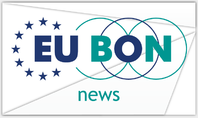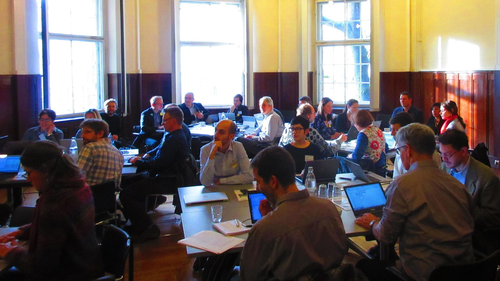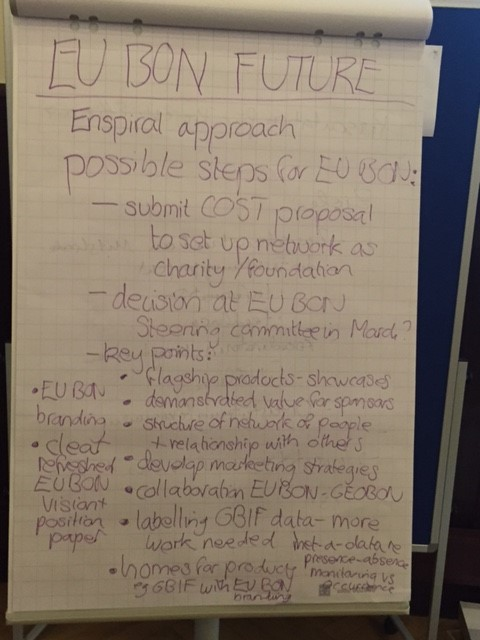
The 4th EU BON roundtable took place on 17 November 2016 in the Museum für Naturkunde in Berlin. Focused on the topic "Pathways to sustainability for EU BONs network of collaborators and technical infrastructure" the 35 participants discussed key questions with regards to the sustainability of the EU BON network and products, and shared their rich expertise, coming from different backgrounds ranging from science to policy.
The Roundtable brought together key European users and stakeholders, such as the European Environment Agency, UNEP GRID, and the GEO secretariat, including 27 different institutions and organisations, as well as European funded projects, infrastructures and networks that share the EU BON objectives of assembling biodiversity and ecosystem-related data and knowledge, such as Lifewatch, the European Citizen Science Association (ECSA), ECOPOTENTIAL, EKLIPSE and others.

Credit: Florian Wetzel
In her welcome address, Katrin Vohland, head of the Science Programme "Public Engagement with Science" and task lead for stakeholder engagement in EU BON explained that key lessons learnt are that:
-
stakeholder identification may yield unexpected results as in the case of EU BON where next to scientifically based organisation less practitioners but more citizen scientists seem to become stakeholder;
-
early and continuous connections are necessary, as for example to other EU initiatives and projects;
-
target group specific communication avoiding acronyms helps; and
-
the idea of teal organisations may support overcoming the limitations to make networks economically sustainable - which are important but non-monetary assets.
While former Roundtables addressed European policy, citizen science and the link to practitioners, this final EU BON Stakeholder event discussed the future and sustainability of the European biodiversity observation network and its products and tools.
Key questions for the participants were:
-

How can the many different EU BON products be sustained and further developed after the project ends in May 2017?
-
Which institutions will host the products in the future and what key products could be further developed by EU BON to meet European and global policy and research needs (e.g. for monitoring, reporting)?
-
How can a European Biodiversity Network as a whole be sustained in order to serve as a central infrastructure and pool of expertise for generating biodiversity data and information on a European scale?
Ideas and plans were developed to secure the sustainability and long term re-use of EU BON products. More information on the outcomes of the meeting can be found below in the minutes and the presentations given during the day.
The report form the meeting was officially published in RIO Journal as a part of the dedicated EU BON outputs collection:
Wetzel F, Despot Belmonte K, Bingham H, Underwood E, Hoffmann A, Häuser C, Mikolajczyk P, Vohland K (2017) 4th European Biodiversity Observation Network (EU BON) Stakeholder Roundtable: Pathways to sustainability for EU BONs network of collaborators and technical infrastructure. Research Ideas and Outcomes 3: e11875. https://doi.org/10.3897/rio.3.e11875
For further information please contact:
Dr. Katrin Vohland, Museum für Naturkunde Berlin, Email: katrin.vohland@mfn-berlin.de
Dr. Florian Wetzel, Museum für Naturkunde Berlin, Email: florian.wetzel@mfn-berlin.de
Presentations from the meeting:
2. Key achievements _ Christoph Häuser
3.1 EUBON Products_ Lauren Weatherdon
3.2 EU BON products and stakeholders_David Rose
4. EU BON and modelling tools_Bill Kunin
5. CS and EU BON tools_Bernat Claramunt
6. Businessplan_Sustainability_Dirk Schmeller
7 .EKLIPSE_EUBON_Carsten Nesshöfer-Dirk Schmeller
8. EEA - EEA_EU BON_Beate Werner
9. LifeWatch_Wouter Los_Christos Arvanitidis
10. Thoughts on Sustainability_Gary Geller
11. Biodiversity data, gaps and effors_Florian_Wetzel
12. EUBON-portal_Tim Robertson




 RSS news
RSS news Print this article
Print this article
